
In this manual, it is detailed how to configure Windows 10 paging file and previous versions of the system: to increase it, reduce, disable at all or transfer to another disk. As well as on existing recommendations relating to the correct configuration of virtual memory.
- What happens when the paging file is disabled
- Windows 10 paging file
- How to zoom, reduce, disable paging file
- Video instruction
- Configuring Windows 8.1 and Windows 7 Paddock File
- Video: Change virtual memory settings
- Correct Paddock File
What will happen if you turn off the paging file
When the paging file is disabled, sometimes everything works as before. But with a small amount of RAM (or when using the process resource resources of processes), you can get a warning message: "There is not enough memory on the computer. To free up memory for normal programs, save files, and then close or restart all open programs "or" To prevent data loss, close the program. " Also, when the swap file is disabled, the memory dumps are not saved in the system failures.

But not always: the option is distributed when the programs simply "fly out" or the error is difficult to associate with the virtual memory disabled (especially if it was a long time ago). Therefore, if you disabled the paging file and ever collide that the programs report on your own errors (for example, an output error in OBS), or silently do not start (Premiere Pro), knock out a black screen (Photoshop), I recommend to try to turn on first his.
By default, Windows 10, 8.1 and Windows 7 automatically determine the size of the paging file according to the system needs and features of the work. According to some users, in some cases, changing the paging file can help optimize the operation of the system, it can sometimes be advisable to turn it out at all, and in some other situations the best - do not change anything and leave the automatic definition of the swap file size. In this manual, how to enlarge, reduce or disable the paging file and delete the Page File.sys file from the disk, as well as what the recommendations exist on correctly configuring the paging file, depending on how you use the computer and its characteristics. .
Windows 10 paging file
In addition to the PageFile.sys swap file, which was also in previous versions of the OS, there is a new hidden SWAPFile.sys system file in Windows 10 as well as in the root of the disk system partition and, in fact, also represents a kind of paging file used not for ordinary ("Classic Application" in Windows 10 terminology), and for "universal applications" UWP.
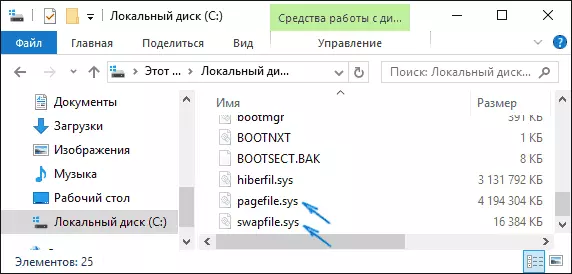
The new swapfile.sys swap file was required due to the fact that for universal applications there were ways to work with memory and, unlike conventional programs that use the paging file as a regular RAM, the file swapfile.sys is used as a file stored "full" The state of individual applications, a kind of hibernation file of specific applications from which they may in a short time can continue to work when contacting. Anticipating the question of how to remove swapfile.sys: Its presence depends on whether the regular paging file is enabled (virtual memory), i.e. It is removed in the same way as the Page File.sys, they are interconnected.
How to enlarge, reduce or disable paging file in Windows 10
And now about the configuration of the paging file in Windows 10 and how it can be enlarged (although it is probably better to simply set the recommended system parameters), reduce if you think that you have enough RAM on your computer or laptop, or Fully disable, thereby freeing the place on the hard disk.
- In order to go to the Windows 10 paging file settings, you can simply start typing the word "performance" in the search field, after which you select "Setting the presentation and system performance" item. The second option to get to the desired window - Press the keys Win + R. on the keyboard, enter sysdm.cpl And press ENTER, then on the Optional tab, in the "Speed" section, click the "Parameters" button.

- In the window that opens, select the "Advanced" tab, and in the "Virtual Memory" section, click the Edit button to configure virtual memory.
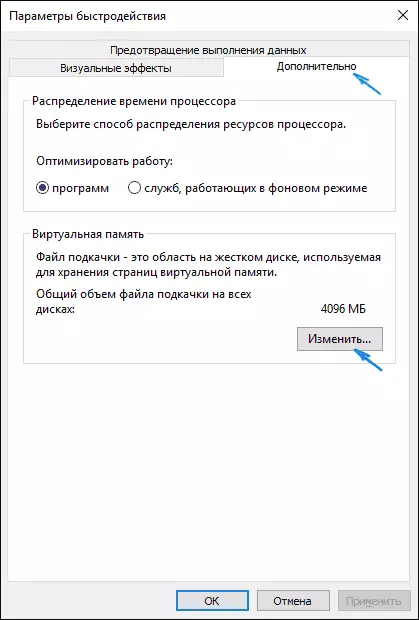
- By default, the parameters will "automatically select the load of the paging file" and today, perhaps, this is my recommendation for most users.
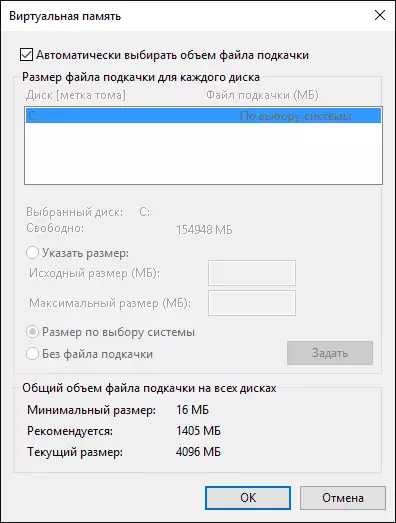
- In order to increase or decrease, i.e. Set manually size of the paging file, remove the mark with automatic size determination, check the "Specite" item and set the desired size and click the Set button. After that apply the settings. Changes come into force after Windows 10 reboot.
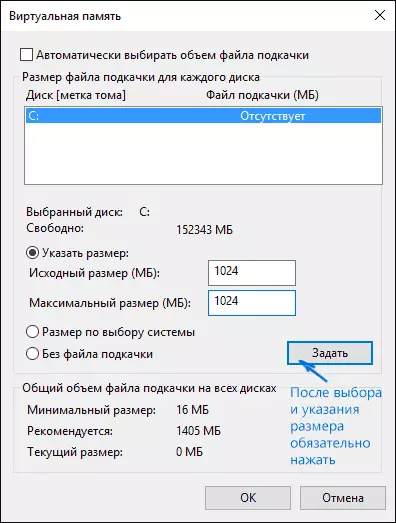
- To disable the paging file and delete the PageFile.sys file from the C disk, select "Without paging file", and then click the "Set" button on the right and apprutely answering the message that appears as a result and click OK.
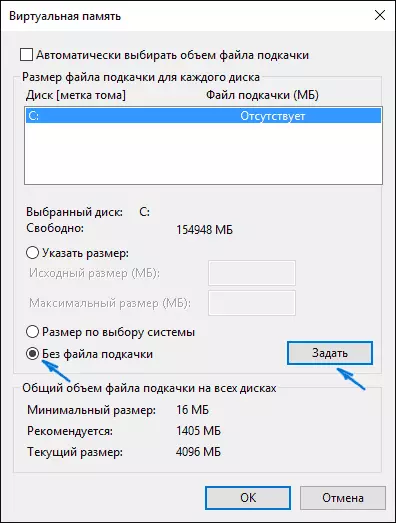
- The paging file from the hard disk or SSD disappears not immediately, and after restarting the computer, it will not be possible to delete it manually to this point: you will see a message that it is used. Next, the article also has a video that shows all the above operations to change the paging file in Windows 10. It can also be useful: how to transfer the paging file to another disk or SSD.
Video instruction
Configure Windows 7 and 8.1 paging file
Before talking about what size of the paging file is optimal for various scenarios, I will show how you can change this size or disable the use of Windows virtual memory.

To configure the parameters of the paging file, go to the "Computer Properties" (Right click on the "My Computer" icon - Properties "), after which you select" System Protection "in the list on the left. A faster way to do the same thing - press the Win + R keys on the keyboard and enter the SYSDM.CPL command (suitable for Windows 7 and 8).

In the Open tab "Advanced" dialog box, and then click on the "Parameters" button in the "Speed" section and also select the Advanced tab. Click the Edit button in the "Virtual Memory" section.
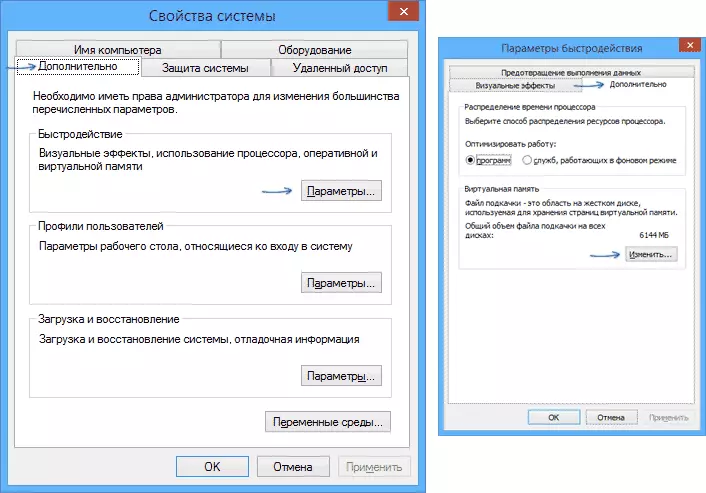
Just here, you can configure the necessary virtual memory parameters:
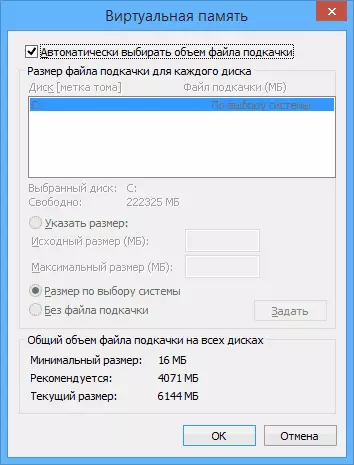
- Disable virtual memory (paging file)
- Reduce or enlarge windows paging file
Changing Windows Switch File Settings - Video
Below is a video instruction on how to configure the paging file in Windows 7, 8.1 and Windows 10, set its size or delete this file, as well as transfer it to another disk. And after the video you can find recommendations on correctly configuring the paging file.Correct Paddock File
There are many different recommendations on how to properly configure the paging file in Windows from people with a variety of levels of competence:
- For example, one of the Microsoft SysInternals developers recommends setting the minimum size of the paging file equal to the difference between the maximum amount of memory used during peak load and the physical volume of RAM. And as the maximum size - the same number multiplied by twice.
- Another frequent recommendation, not devoid of grounds - use the same minimum (source) and the maximum size of the paging file in order to avoid fragmentation of this file and, as a result, reducing performance. This is not relevant for SSD, but it can be quite meaningful for HDD.
- Well, the setting option, which you have to meet more often than others - disable the Windows paging file if there is a sufficient amount of RAM.
Most of your readers, I would not recommend this to do, because in case of problems when you start or work programs and games, you can not remember that these problems can be caused by disconnecting the paging file. However, if you have a strictly limited set of software that you always use, and these programs work perfectly without paging file, this optimization is also entitled to life.
Transferring a paging file to another disc
One of the options for configuring the paging file, which in some cases can be useful for system performance - transfer it to a separate hard disk or SSD. At the same time, it is precisely a separate physical disk, and not the partition on the disk (in the case of a logical section, the transfer of the paging file, on the contrary, can lead to a drop in performance).
How to transfer the paging file to another disc in Windows 10, 8 and Windows 7:
- In the settings of the paging file (virtual memory), turn off the paging file for the disk on which it is (select the "Without paging file" and click "Set".
- For the second disk to which we carry the paging file, set the size or install it by selecting the system and also click "Set".
- Click OK and restart the computer.
However, if you want to transfer the paging file with an SSD to an HDD in order to extend the life of a solid-state drive - it is possible to do this and should not be, unless you have an old SSD with a low container. As a result, you lose in performance, and an increase in service life may be very insignificant. Read more - Setting up SSD for Windows 10 (relevant and for 8-ki).
Attention: The following text with the recommendations was written by me about two years ago and in some items are not quite relevant: for example, for today's SSD, I no longer recommend turning off the paging file.
In various articles related to Windows optimization, you can find the recommendations to disable the paging file if the size of the RAM is 8 GB or even 6 GB, and not to use the automatic selection of the paging file. The logic in this is - when the paging file is disabled, the computer will not use the hard disk as an additional memory, which should increase the speed of operation (RAM at times faster), and when manually specifying the exact size of the paging file (it is recommended to specify the original and maximum The size is the same), we release the location on the disk and remove the task with the task to configure the sizes of this file.
Note: If you are using an SSD disk, it is best to assume to set the maximum amount of RAM and completely disable the paging file, this will extend the life of the solid-state disk.
In my opinion, it is not entirely true and first of all, you should navigate not so much on the size of the available physical memory, how much does the computer use, otherwise, you risk seeing messages that Windows is not enough memory.
Indeed, if you have 8 GB of RAM, and work at a computer is to view sites and multiple games, it is likely that it is likely that to disable the paging file will be a good solution (but there is a risk to encounter a message that not enough memory).
However, if you mount the video, edit photos in professional packages, work with vector or three-dimensional graphics, design homes and rocket engines, use virtual machines, 8 GB RAM will be a little and the paging file will certainly be required during operation. Moreover, turning it off, you risk losing unsaved documents and files when the memory lack occurs.
If you are not sure how many RAM you need and what size of the paging file will be correct in your situation, there is the following approach to the definition of its size, do not pass for its truth and applicability for each user:
- Run on the computer all those programs that, in theory, you can run simultaneously - Office and Skype, open the Tens of YouTube tabs in the browser, run the game (use your work scenario).
- Open the Windows Task Manager until all this is started and on the Speed tab, see what kind of RAM size is involved.
- Increase this number 50-100% (the exact number will not be ladies, but would recommend 100) and compare with the size of the physical memory of the computer.
- That is, for example, on PCs 8 GB of memory, 6 GB is used, we double (100%), it turns out 12 GB. We subtract 8, set the size of the 4 GB paging file and can be relatively calm for the fact that the problems with virtual memory will not occur even with critical versions of work.
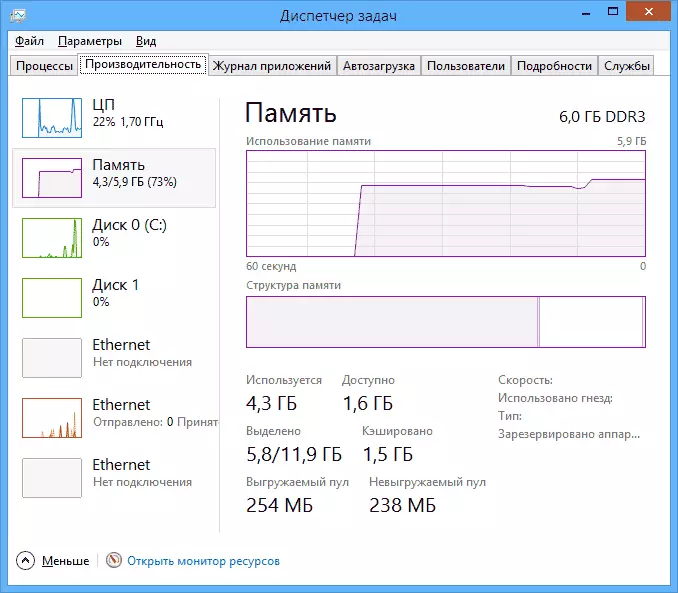
My personal view on the paging file as of the last update of this article - leave its size automatically defined by the system and, if possible, it is on SSD, provided that you need high performance. On the Internet you can find recommendations that are significantly different from what I suggest. What of them to follow - to solve you. When using my option, you will most likely not come across the situation when the program does not start due to a lack of memory, but the option is to fully disable the paging file (which I do not recommend for most cases) theoretically may have a positive effect on the system performance in Some cases.
